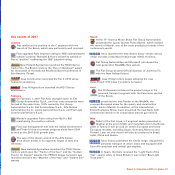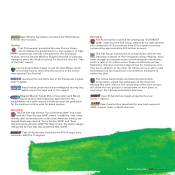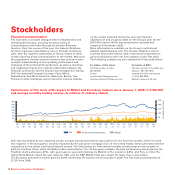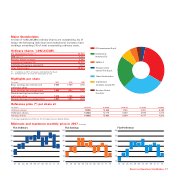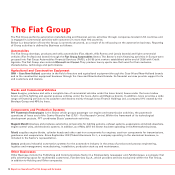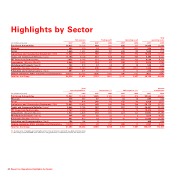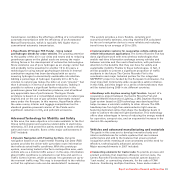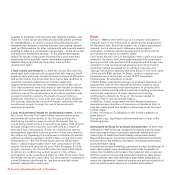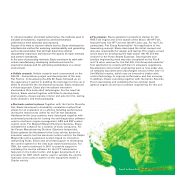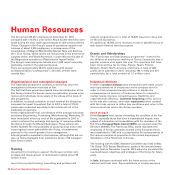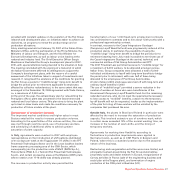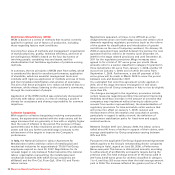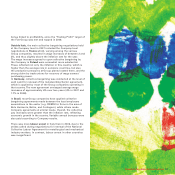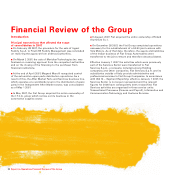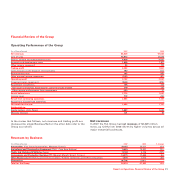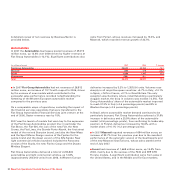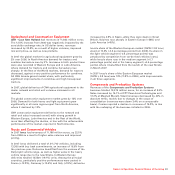Chrysler 2007 Annual Report Download - page 24
Download and view the complete annual report
Please find page 24 of the 2007 Chrysler annual report below. You can navigate through the pages in the report by either clicking on the pages listed below, or by using the keyword search tool below to find specific information within the annual report.transmission combines the effortless shifting of a conventional
automatic transmission with the efficiency of an Automated
Manual Transmission, which is typically 10% higher than a
conventional automatic transmission.
■HyperPanda (HYdrogen PER Panda) - Using natural
gas/hydrogen blends for urban vehicles. The growing attention
to the quality of the air in our cities and towns and to reducing
greenhouse gases on the global scale are among the major
driving forces in the development of automotive technologies.
Since extensive use of pure hydrogen as an energy carrier fuel
will probably not be possible for another 15 to 20 years, a
technology for using natural gas/hydrogen blends in internal
combustion engines has been developed with an eye to
ensuring hydrogen’s economically sustainable introduction.
Adding a percentage of hydrogen (typically 20 to 30 % by
volume) to natural gas makes the latter an even “greener” fuel
than it already is in terms of pollutant emissions, making it
possible to achieve a significant further reduction in the
greenhouse gases that combustion produces, and all without
any appreciable loss of performance. The Hyper Panda
prototype is based on a consolidated experience in natural gas
engines and on the use of gas cylinders that neatly stowed
away under the floorpan. In this manner, HyperPanda offers
the same roomy interior and luggage compartment as the
standard gasoline-powered version of the Panda and a
significant reduction in CO2and pollutant emissions.
Advanced Technology for Mobility and Safety
In this area, the main objective is to make available to the Fiat
Group technological and systems-related skills in electronics,
telematics, ICT and preventive safety needed to make vehicles
safer and more versatile. Some of the major achievements in
2007 included:
■Dynamic Navigation with Floating Car Data. Dynamic
navigation based on an experimental Floating Car Data (FCD)
system provides the driver with up-to-date route information
that reflects actual traffic conditions. With this prototype
system, now being tested in the Turin metropolitan area, each
vehicle acts as a mobile traffic sensor: in this way, information
about traffic conditions is collected in real time and sent to a
Traffic Control Center, which processes it to generate an up-to-
the-moment traffic map. This map is transmitted to the vehicles
so that the optimum route can be recalculated if necessary.
This system provides a more flexible, complete and
economical traffic estimate, ensuring that the ETA calculated
by the car’s navigation device is more reliable and reducing
travel times by an average of 20 to 25%.
■Communication systems for cooperative vehicle-vehicle and
vehicle-infrastructure applications. The Centro Ricerche Fiat has
done significant work with new wireless technologies that
enable real-time information exchange among vehicles and
between vehicles and the road infrastructure, with particular
attention to the benefits that they can have for safety and
sustainable mobility. Thanks to these technologies, in fact, it
will be possible to prevent a significant proportion of traffic
accidents in the future. The Centro Ricerche Fiat is the
coordinator and major technical partner for the integrated
SAFESPOT project co-funded by the European Commission, the
most important Community-wide cooperative safety initiative.
In this field, activities began on a series of demonstrators that
will be tested during 2009 in six different countries.
■Headlamp with daytime running light function. As part of a
cooperative project between the Centro Ricerche Fiat and
Magneti Marelli Automotive Lighting, a DRL Daytime Running
Light system based on LED technology was developed that
helps increase a vehicle’s visibility to other drivers. The DRL
headlamp has five high-flux semiconductor light sources
featuring dedicated optics that shape the headlamp beam in
order to achieve the desired light distribution. This technology
offers clear advantages in terms of reducing the energy needed
for operation, compact size, and an exponential increase in the
device’s life expectancy.
Vehicles and advanced manufacturing and materials
The goals in this area are to develop innovative body and
interior architectures for vehicle systems that can increase
performance and add to the features that ensure product
recognition while meeting all cost constraints and the need for
effective, technologically advanced solutions.
Major accomplishments in 2007 included:
■Connecting elements for tractor cabs. To provide process and
product solutions that maximize efficiency and cut costs, the
Centro Ricerche Fiat developed a modular system based on
“cast nodes”, or connecting elements, for the cabs of CNH
tractors. Combining multiple functions, these nodes make it
Report on Operations Research and Innovation 23


